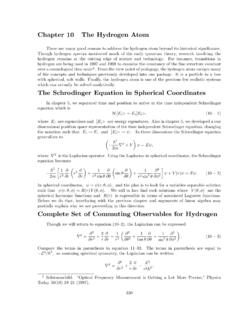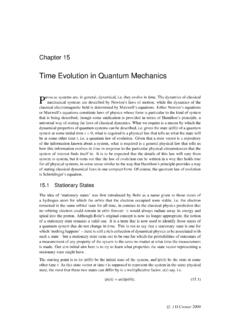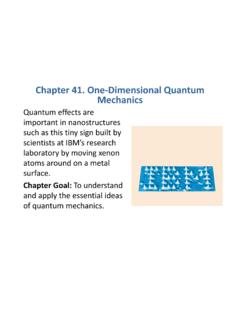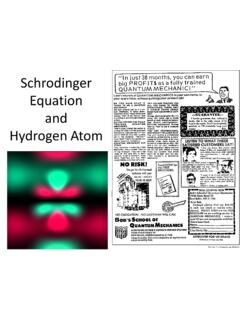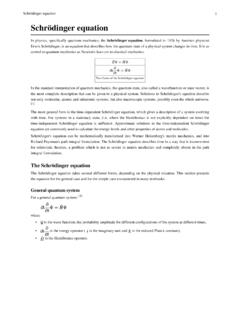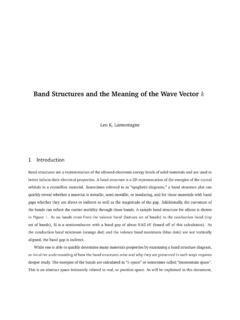Transcription of The Schrödinger Equation in One Dimension
1 1 The Schr dinger Equation in One Dimension Introduction We have defined a complex wave function (x, t) for a particle and interpreted it such that 2(,rtdx gives the probability that the particle is at position x (within a region of length dx) at time t. How does one solve for this wave function? Presumably, it obeys some kind of wave Equation similar to the wave Equation that describes classical waves (tension waves, pressure wave, electromagnetic waves). The classical wave Equation , which is a differential Equation , can be solved subject to conditions imposed by the particular system being studied.)
2 For example, the Equation describing the waves generated by a plucked guitar string must be solved subject to the condition that the ends of the string are fixed. Such conditions are called boundary conditions, and the solutions of the wave Equation must be consistent with them. These solutions give one a complete description of the dynamical behavior of the wave disturbance in the medium. For a single, classical particle, one solves Newton s second law Fma= (which is also a differential Equation ) to find the dynamical behavior of the particle.
3 Newton s second law is solved subject to boundary conditions ( , initial position and velocity) and the solutions x(t) and v(t) (one dimensional) give all the information about the dynamics of the particle for all time. Our quantum wave Equation will play the same role in quantum mechanics as Newton s second law does in classical mechanics. It will represent the fundamental Equation of motion of a matter wave, which when solved subject to boundary conditions, will give us the wave function (,).rt (,)rt provides a complete statistical description of the dynamics of the particle in terms of average values for the dynamical quantities such as energy, momentum and Like Newton s second law, our quantum wave Equation cannot be derived.
4 It must be postulated and then shown to be consistent with experiment. What are some of the properties that the quantum wave Equation should have? (1) Linear, homogeneous differential Equation . This ensures that the principle of superposition is valid, , if 1 is a solution and 2 is a solution, then 1 + 2 is also a solution. We saw that we can construct a wave packet from a superposition of pure sinusoidal waves. If the elementary waves are solutions to the quantum wave Equation , then superposition ensures that the wave packet will be a solution also.
5 (2) It must be consistent with the de Broglie-Einstein relations. Thus, total energy Ehf == . Momentum p of particle is given by /.phk == (3) It must be consistent with the conservation of energy, which we expect to remain valid in quantum mechanics. Thus, K + U = E, where K is kinetic energy, U is potential energy, and E is total energy, which is conserved. 1 Do flow chart: Equation of motion+ (,),,xtpxE 2 In this course, we shall deal exclusively with non-relativistic particles. Hence, K = p2/2m, and E represents the total mechanical energy ( , the sum of the kinetic and potential energies, not the relativistic mass-energy).
6 Obtaining the schrodinger Wave Equation Let us now construct our wave Equation by reverse engineering, , we start with a wave function solution and work backwards to obtain the Equation . We shall first postulate the wave function for the simplest conceivable system: a free particle. We saw that a pure sinusoidal wave can by represented by 1(,)cos().xtAkxt = ( ) This wave has a single precise value of wave number k (momentum k ) and single frequency (energy ). The momentum and energy do not change with time, which is consistent with the behavior of a free particle.
7 Note also that the Heisenberg Uncertainty Principle tells us that since E = 0, the particle has the same precise energy for all time, and since p = 0, it has the same precise momentum in all space. [We know that 21dx but we shall overlook this detail in our subsequent All other properties of the wave are well-behaved, and the bad behavior at infinity will not affect the construction of our wave Equation .] Now, the harmonic wave 2(,)sin().xtBkxt = ( ) is just as good a representation of a free particle as Eq. ( ).3 So is the superposed solution 12(,)(,)(,)cos()sin().
8 XtxtxtAkxtBkxt = + = + ( ) ---------------------------------------- ---------------------------------------- ------------------------------------- Mathematical Aside: Complex Numbers We now find it convenient to introduce the complex exponential cossin,iei =+ ( ) which is called Euler's formula. Eq. ( ) can be proved by using the power series expansions for ex, cos x, and sin x. Proof: 22112!3!232311112!3!2!3! ()().. xiexxxeiiiii =++++=++++=+ + 24112!4!35113!5!35113!5! = + = += + 23112!3! .iiiie +=+ += Consider complex number z = x + iy 2 We can always find appropriate solutions by superposition.
9 3 Plot with Mathematica Im z Re z z y x Complex Plane 3 The complex conjugate of z is z* = x iy. The complex conjugate of any complex number is obtained by replacing i by i wherever it occurs. Note that |z|2 = x2 + y2 = z*z. ---------------------------------------- ---------------------------------------- ------------------------------------ We have argued that we can represent our free particle by the superposition (,)cos()sin().xtAkxtBkxt = + Since i is a constant, we can use the complex exponential instead of this sum: ()(,). (Free particle traveling in + direction)ikxtxtCex = ( ) Also, ()(,).
10 (Free particle traveling in direction)ikxtxtDex + = ( ) Let us take a snapshot of our wave function, , we fix the time, and so we can concentrate on the spatial variation. Then our wave function Eq. ( ) becomes ().ikxxCe = ( ) Now, from the de Broglie relation, the kinetic energy K = p2/2m = From Eq. ( ), = = Hence, = = Now, for a free particle, U = 0, so E = K. If U is not zero, then K = E U. Substituting in the above Equation yields 222(),2dEUmdx = or, 222()()()().2dxUxxExmdx += ( ) Eq. ( ) is the Time-Independent schrodinger Equation (TISE) in one Dimension .

